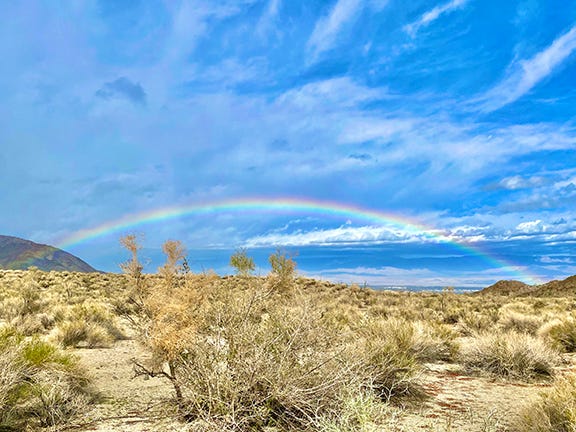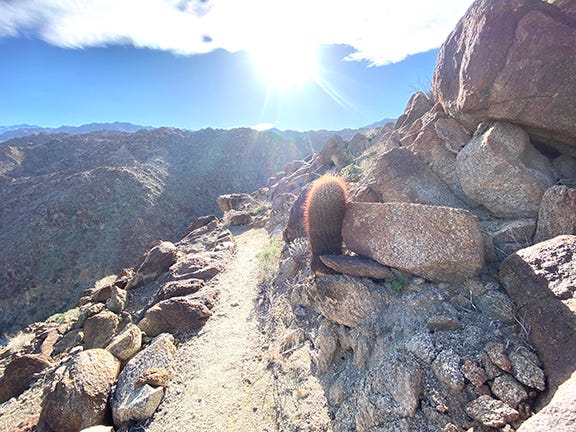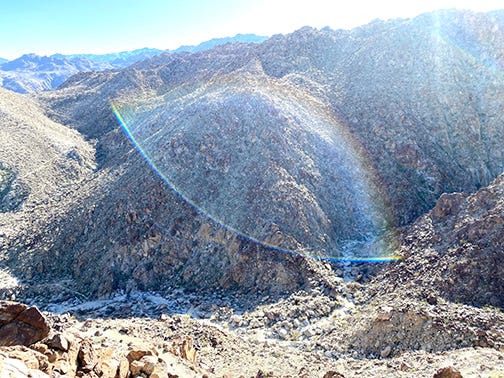One of our favorite books set in Southern California Native American homelands is also the first literary anthology devoted to California’s deserts, No Place for a Puritan: The Literature of California's Deserts (Heyday, 2009). Alongside the well-known desert-region writers such as Edward Abbey, Mary Austin, and Barry Lopez, are more local storytellers and poets, such as Susan Straight, and Juan Felipe Herrera.
And Dorothy Ramon.
This week the anthology editor, poet Ruth Nolan, shares with us her love of the “real desert” and its power to revive the soul.
Photo © copyright Ruth Nolan
The Real Desert In Winter
By Ruth Nolan
It’s not hard to be lured in to the southernmost California deserts in the winter season, sharp and harsh as they tend to be, geographically. A shimmering jewel in the crown of fabled Southern California, in itself effluent with winter balm and citrus fruits and gentle sunshine, the deserts and surrounding mountains of the Coachella Valley glimmer at this time of year with sunshine, daytime temperatures in the 60s and 70s, and a quality of air that can make people cry. It’s that beautiful, that inviting, that soothing. Especially for those getting off of airplanes in Palm Springs from frozen places far away. For them, the experience of entering our precious desert space can profound, soul-thawing, transformational.
Yes. The tourists are here again in record-breaking numbers again this winter season, pulled by the invigorations of perfect weather, staggering scenery, and the desperate desire to push past three years of the unfathomable ravages the Covid pandemic has wrought upon our world and seek ecstatic divinity once again and experience the type of soul-reviving catharsis that is so generously granted by the power and stature of our desert, in a season that is nourishing and motherly, a season that nurtures and heals.
This desert, in winter, is a friend, not a foe. And in its rarified daytime light and glittering dark night skies full of stars or astonishing moons, this place guides us along our way from horror into beauty once again. Come and thaw out and imbibe in a hot-tub soak, before going back to where it’s cold, snowy, harsh, impersonal. And when your summer comes, gentle and green, our real winter desert will have been vastly altered into a hot resemblance of a special form of hell. But of course, you won’t be here then.
And what the tourists may not know is this: there is a Real Desert at this time of year, in supple and light-hearted winter. It lurks behind the curtained luxury of our valleys’ many jam-packed resorts; in the shadows of the mid-century architectural wonders of Modernism Week; in the cracks of the sidewalks of modern-day Palm Springs with its mountain-blocking high rises; on a side plateau of the over-run Coachella Valley Preserve. In enduring contrast to an increasing Disneyland feel to the many entertainment events of this place, the Real Desert in winter lives fiercely and softly in the deep spirit of this sacred, unlike-any-other land, rooted inextinguishably and inseparably from what is real.
Photo © copyright Ruth Nolan
Its heart is enshrined in our few remaining sand dunes which at this time of year, now past mid-winter and six weeks out until the official arrival of spring, are singing and rejoicing with carpets of pink sand verbena and love songs trumpeting from sheet-white hanky flowers of dune primrose. Never mind the massive tractors clearing 4-square miles of one of the last, largest sets of intact dunes in Rancho Mirage for a massive new resort being built. Those flowers. This winter. They are fierce and soft simultaneously. They are out in full force until the last death blow.
Photo © copyright Ruth Nolan
Pushing past the invasive fat-tired electric mountain bike tire tracks — as wide and disruptive to the soil and sand as dirt bikes — that defile our most sacred desert canyons at this time of year, and stopping to knock down desecrating rock-stacks along every single hiking trail with my hiking stick, I come upon even more power and beauty on the edge of urbanization.
Photo © copyright Ruth Nolan
From precarious cliff edges high into the Cahuilla Hills, I peer down upon unreachable Washingtonian fan palm oases tucked at the bottom of massive rock waterfalls. A huge redtail hawk rises above me, invigorated by a sudden fit of Santa Ana wind. In front of me, abundant fresh piles of Bighorn Sheep droppings, though no sheep in sight today. Tough agave plants enduring as they have for thousands of years, iridescent mint green and striking against rust-colored rocks in this place they call home.
One misstep in desert places like this can be deadly. Even in the heart of winter. Respect is essential at all times. Rule No. 1 in Desert Winter. Carry water.
Photo © copyright Ruth Nolan
I wonder if our desert’s Cahuilla people ventured to this specific place in their times of agave harvesting, if I’m witnessing a testament to a centuries-old ritual. And back into the canyon, past the encroachment of mountain bikes, I’m gifted with the sight of an old grinding stone smoothed across the surface of a warm boulder and a few pieces of lithic scatter from someone who lived and passed through here long ago.
Photo © copyright Ruth Nolan
Winter in the Real Desert. Rainbows across the valley from one jut of the Santa Rosa– San Jacinto Mountain foothills in a landscape juxtaposed between cloud and rain and pure sun, and tossed with a dose of January storm wind. December stillness just before the rains come, in places where heavy water poured down from our surrounding peaks and plateau during this past summer’s epic monsoon rainfalls —starting in late July and lasting deep into last fall, hillside and canyon Ocotillo exploded in the brightest and thickest green I’ve ever seen, following by a hot red super bloom.
And in January, a rather unseasonably cold and wet month this winter, spring wildflowers blooming in certain canyons, smaller versions of themselves than in warmer months, but definitely thriving. Purple phacelia and yellow brittlebush have been especially prominent. And a datura flower superbloom in one special canyon that I shall not name. The entire canyon mouth, fluorescent all at once.
The Real Desert in Winter is the timeless soul of the integrity of our land. It is a time when temperatures are forgiving and friendly, a time that tourists can’t easily know counterbalances our months of extreme and deadly heat. Summer, that counterpoint we all dread and await in dismay as winter folds into an early and short spring. We’re on the cusp now.
Our days and nights of rare and exotic tiny wildflower wanderings in this special winter season — filled with the blessing of abundant rain that we haven’t seen in the past few winters and marked with hope for a return to better times — alternate between early morning chill and the sudden onset of temperatures shooting up to 80 degrees.
And the noise and chaos and large-scale tourism continues louder and louder at this time of year, as it will every night and day until summer is just around the bend. But in the Real Desert in Winter, I recommend you venture into the silence of the land in hidden canyons, where you might just be surprised to see waterfalls cascading down rocks as you hike around a bend in places like Tahquitz Canyon and become elated inexplicably by the sound of water in this, a most arid and silent place.
Photo © copyright Ruth Nolan
There is so much to learn about this land of contrasts and delights, in this winter of cool and sun-splashed dreams and time. And much to learn from.
Thank you, Ruth! Ruth Nolan is a native of the Mojave Desert who teaches at College of the Desert near Palm Springs, California. She is also a poet, writer, and book editor/publisher. For two summer seasons, 1986-87, she worked for the BLM as a helicopter hotshot and engine crew firefighter in the California Desert District, and has extensively hiked, traveled, and embraced the essence of her desert homeland.
She’ll be at Dorothy Ramon Learning Center’s Native Voices Poetry Festival on March 11, 2023, with Inlandia Institute. Other publishers, including Heyday Books and News from Native California magazine, Malki Museum, and Dorothy Ramon Learning Center, also will offer books for sale. And you can look for a good read at our Little Free Library at the Festival, courtesy of Friends of Banning Library and Banning Library District.
So much more will be at Dorothy Ramon Learning Center’s Native Voices Poetry Festival, our 7th regional celebration of the Native voice in all the arts. This year Idyllwild Arts Native American Arts Center is our major sponsor and partner. Come enjoy Native American singing, storytelling and other performances, along with loads of cultural activities and family fun such as Native food tasting. Especially popular are our creative writing and art workshops for all ages. It’s all free, at Dorothy Ramon Learning Center, 10-4 pm March 11, 2023, 127 N. San Gorgonio Ave., Banning. MORE INFORMATION HERE.
Thanks to you, the 501c3 nonprofit Dorothy Ramon Learning Center, led by Elder Ernest Siva (Cahuilla-Serrano), is in its 20th year of saving and sharing Southern California’s Native American cultures, languages, history, and traditional arts.
And thanks, as always, for reading, sharing, and subscribing to our free online newsletter, News from Dorothy Ramon Learning Center, from Center leaders Ernest and June Siva, and Editor Pat Murkland. We value you and your ideas: Please EMAIL. February 8, 2023.











